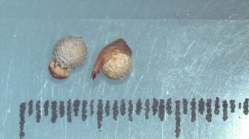Cyperaceae taxon details
Scleria ciliata Michx.
1681667 (urn:lsid:marinespecies.org:taxname:1681667)
accepted
Species
Acorus brasiliensium Schott ex Nees · unaccepted
Scleria melanomphala var. macrantha (Boeck.) Boeck. · unaccepted
- Variety Scleria ciliata var. ciliata Michx.
- Variety Scleria ciliata var. elliottii (Chapm.) Fernald
- Variety Scleria ciliata var. glabra (Chapm.) Fairey
- Variety Scleria ciliata var. curtissii (Britton) J.W.Kessler accepted as Scleria pauciflora var. curtissii (Britton) Fairey
- Variety Scleria ciliata var. glabrescens Maury accepted as Scleria ciliata var. ciliata Michx.
- Variety Scleria ciliata var. pauciflora Kük. accepted as Scleria ciliata var. ciliata Michx.
terrestrial
Not documented
Description Plants perennial; rhizomes elongate, knotted, rather stout. Culms sometimes in tufts, erect, stout to slender or almost...
Taxonomic remark Source in seed data: wcs Update namepublishedIn from Fl. Bor.-Amer. 2: 167 1803 to Fl. Bor.-Amer. 2: 167 (1803),...
Description Plants perennial; rhizomes elongate, knotted, rather stout. Culms sometimes in tufts, erect, stout to slender or almost filiform, 20–70 cm, glabrous or hairy, especially on angles distally. Leaves: sheaths sometimes purplish, not or scarcely winged, weakly ribbed, densely pubescent or glabrous; contra-ligules subrotund to triangular, short; blades linear, keeled, obtuse, shorter than, equaling, or overtopping culm, 1–7 mm wide, ciliate or glabrous. Inflorescences terminal and axillary, fasciculate, 0.5–2.5 cm; clusters few to many flowered, 5–10 mm wide, each with 2–4(–5) spikelets; axillary clusters sometimes on short erect to slender filiform peduncles; bracts subtending inflorescence leaflike, awl-shaped, to 15+ cm, often appearing to be continuation of culm, conspicuously ciliate or glabrous. Spikelets bisexual and staminate, 4–8 mm; staminate scales lanceolate, membranous; pistillate scales ovate-acuminate, midrib conspicuous. Achenes whitish or often brownish gray, globose, 2–3 mm, base constricted, trigonous, apex usually umbonate, tuberculate or verrucose, rarely smooth, papillate at base; hypogynium golden brown, obtusely 3-angled border, supporting 3 yellowish, globose, spiculose or pulverulent, entire or 2-lobed tubercles. [details]
Taxonomic remark Source in seed data: wcs Update namepublishedIn from Fl. Bor.-Amer. 2: 167 1803 to Fl. Bor.-Amer. 2: 167 (1803),...
Taxonomic remark Source in seed data: wcs Update namepublishedIn from Fl. Bor.-Amer. 2: 167 1803 to Fl. Bor.-Amer. 2: 167 (1803), information provided by Alan E. on email Jun. 07 2021 More details could be found in [details]
Cyperaceae Working Group. (2025). [see How to cite]. Global Cyperaceae Database. Scleria ciliata Michx.. Accessed at: https://www.cyperaceae.org/aphia.php?p=taxdetails&id=1681667 on 2025-09-11
![]() The webpage text is licensed under a Creative Commons
Attribution 4.0 License
The webpage text is licensed under a Creative Commons
Attribution 4.0 License
Nomenclature
basis of record
Plants of the World Online (POWO). , available online at https://powo.science.kew.org/ [details]
 Present
Present  Inaccurate
Inaccurate  Introduced: alien
Introduced: alien  Containing type locality
Containing type locality
From editor or global species database
Description Plants perennial; rhizomes elongate, knotted, rather stout. Culms sometimes in tufts, erect, stout to slender or almost filiform, 20–70 cm, glabrous or hairy, especially on angles distally. Leaves: sheaths sometimes purplish, not or scarcely winged, weakly ribbed, densely pubescent or glabrous; contra-ligules subrotund to triangular, short; blades linear, keeled, obtuse, shorter than, equaling, or overtopping culm, 1–7 mm wide, ciliate or glabrous. Inflorescences terminal and axillary, fasciculate, 0.5–2.5 cm; clusters few to many flowered, 5–10 mm wide, each with 2–4(–5) spikelets; axillary clusters sometimes on short erect to slender filiform peduncles; bracts subtending inflorescence leaflike, awl-shaped, to 15+ cm, often appearing to be continuation of culm, conspicuously ciliate or glabrous. Spikelets bisexual and staminate, 4–8 mm; staminate scales lanceolate, membranous; pistillate scales ovate-acuminate, midrib conspicuous. Achenes whitish or often brownish gray, globose, 2–3 mm, base constricted, trigonous, apex usually umbonate, tuberculate or verrucose, rarely smooth, papillate at base; hypogynium golden brown, obtusely 3-angled border, supporting 3 yellowish, globose, spiculose or pulverulent, entire or 2-lobed tubercles. [details]Taxonomic remark Source in seed data: wcs Update namepublishedIn from Fl. Bor.-Amer. 2: 167 1803 to Fl. Bor.-Amer. 2: 167 (1803), information provided by Alan E. on email Jun. 07 2021 More details could be found in [details]
To Biodiversity Heritage Library (106 publications)
To Biodiversity Heritage Library (4 publications) (from synonym Acorus brasiliensium Schott ex Nees)
To European Nucleotide Archive, ENA (Scleria ciliata)
To GenBank (8 nucleotides; 5 proteins)
To International Plant Names Index (IPNI)
To International Plant Names Index (IPNI) (from synonym Acorus brasiliensium Schott ex Nees)
To IUCN Red List (Least Concern)
To Plants of the World Online (from synonym Acorus brasiliensium Schott ex Nees)
To Plants of the World Online
To The Plant List (from synonym Scleria melanomphala var. macrantha (Boeck.) Boeck.)
To Biodiversity Heritage Library (4 publications) (from synonym Acorus brasiliensium Schott ex Nees)
To European Nucleotide Archive, ENA (Scleria ciliata)
To GenBank (8 nucleotides; 5 proteins)
To International Plant Names Index (IPNI)
To International Plant Names Index (IPNI) (from synonym Acorus brasiliensium Schott ex Nees)
To IUCN Red List (Least Concern)
To Plants of the World Online (from synonym Acorus brasiliensium Schott ex Nees)
To Plants of the World Online
To The Plant List (from synonym Scleria melanomphala var. macrantha (Boeck.) Boeck.)




